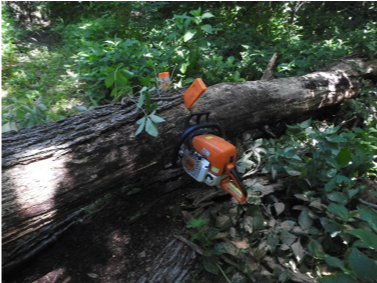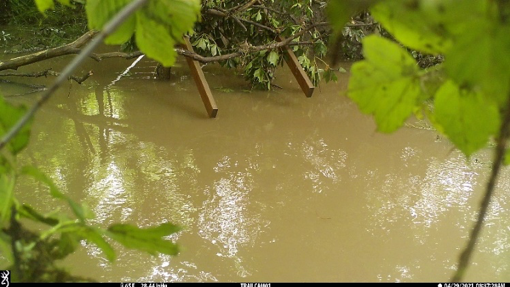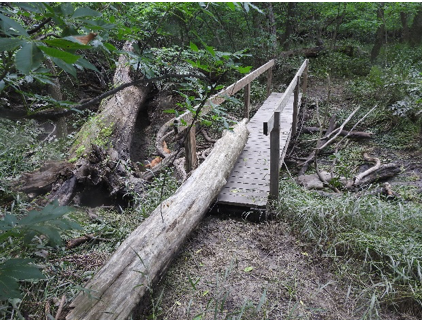Summer 2021 Far West Farm
The perils of nature trail management
After a 4-inch downpour had hit western Morris County on May 27th I was fearful of what Carolyn and I would find when we went to check on our nature trail at Far West Farm. I was particularly concerned that the rain might have severely damaged one or both of our two sets of stairs along Clarks Creek or perhaps had ravaged our bridge that spans an ephemeral stream that dumps into Clarks Creek. I was also concerned that high water might have inundated a trail camera I had placed near the creek.
What we found during our initial visit and what I found on some subsequent visits by myself gave me new appreciation into issues involved in nature trail maintenance . As I think about trail upkeep I am constantly reminded of a casual remark I made during a presentation a year ago that had prompted a response from Kail Katzenmeier. Kail and his wife Becky own Prairiewood, a prairie preserve with facilities for lodging and event planning, in Manhattan. As part of their operation they maintain six miles of walking trails along Wildcat Creek and on their pastureland that are open to the public on weekends.
During a forum on land preservation hosted by Prairiewood, I had said something to the effect that there is a lot more to maintaining a nature trail than one would expect, and Kail, who I had not previously met, approached me after the program to commiserate on the woes of trail maintenance. Up until that time I had somehow thought my experiences with trails maintenance were unusual, but I have since accepted reality: Nature is chaotic, and it doesn’t like trails. Something will always be falling on them, washing over them, or growing out of them.
 Carolyn and I were only 50 yards down our trail when we encountered our first obstacle, a large, approximately 140-year-old, dead bur oak that had fallen directly across the trail. (A photo taken later as I was opening the trail is shown at right. Wedges are driven in halfway through the cut so the saw blade won’t be pinched.) Another 50 yards down the trail we found that two piles of driftwood, which I had aggregated after a previous flood with the intention of burning, had been completely rearranged. Some of the wood now lay atop the trail, which was no longer recognizable. We reached Clarks Creek and our first set of stairs. Remarkably, the stairs were intact, although the layer of mud on each step indicated water had reached nearly to the top rung. This was the second time the stairs had been inundated by a flood without noticeable damage—a testimony to the toughness and utility of deck screws.
Carolyn and I were only 50 yards down our trail when we encountered our first obstacle, a large, approximately 140-year-old, dead bur oak that had fallen directly across the trail. (A photo taken later as I was opening the trail is shown at right. Wedges are driven in halfway through the cut so the saw blade won’t be pinched.) Another 50 yards down the trail we found that two piles of driftwood, which I had aggregated after a previous flood with the intention of burning, had been completely rearranged. Some of the wood now lay atop the trail, which was no longer recognizable. We reached Clarks Creek and our first set of stairs. Remarkably, the stairs were intact, although the layer of mud on each step indicated water had reached nearly to the top rung. This was the second time the stairs had been inundated by a flood without noticeable damage—a testimony to the toughness and utility of deck screws.
I opened the trail camera and was greeted with a gush of water. To my amazement all of the features seemed to be working and I swapped out the memory card…wondering as I did what I would find when I downloaded the pictures. I briefly thought about the effect on wildlife faced with a sudden flood, thinking in particular about the skunk that was observed over the course of many months and seemed to live under the bottom set of steps on the staircase.
 We slipslid up the muddy stairs and moved on down the trail. Seventy-five yards later we had to step over another log--this one placed across the trail by the high water. To my relief the second set of stairs was also in fine shape. My love for deck screws knew no bounds. I remain somewhat astonished that two stairs that I had built without previous experience, and which were primarily composed of redwood repurposed from salvaged decks, had survived without noticeable damage. (The photo at left taken by our trail camera on the day after the downpour shows the beginning of the hand railings on our stairs with water still water six feet above normal level. This water has backed into an oxbow off the main channel of Clarks Creek.)
We slipslid up the muddy stairs and moved on down the trail. Seventy-five yards later we had to step over another log--this one placed across the trail by the high water. To my relief the second set of stairs was also in fine shape. My love for deck screws knew no bounds. I remain somewhat astonished that two stairs that I had built without previous experience, and which were primarily composed of redwood repurposed from salvaged decks, had survived without noticeable damage. (The photo at left taken by our trail camera on the day after the downpour shows the beginning of the hand railings on our stairs with water still water six feet above normal level. This water has backed into an oxbow off the main channel of Clarks Creek.)
We continued along the trail, marveling as we did how high the water had gotten—perhaps 12-15 feet above the normal level of the stream. We moved away from the creek and worked our way across a timbered area until we came to point where I had built a 20-foot-long bridge over a deeply downcut ephemeral stream that dumps into Clarks Creek about 150 yards downstream. At the bridge we were greeted by a 12-foot-long log (photo below) that had somehow settled onto the bridge without taking out the railing on either side of it. Knowing the power of rushing water, I could not fathom how the flood had been able to strand the log on the bridge while doing no damage.
 Subsequent trips to the farm uncovered two more locations where large logs were blocking the trail. We had not accessed that segment of the trail earlier, as it runs down an old oxbow on Clarks Creek and we knew it would be too wet to traverse. On one of my later visits I sawed through the logs blocking our path and was prepared to saw up the log on our bridge, only to be thwarted in my effort by a balky chainsaw.
Subsequent trips to the farm uncovered two more locations where large logs were blocking the trail. We had not accessed that segment of the trail earlier, as it runs down an old oxbow on Clarks Creek and we knew it would be too wet to traverse. On one of my later visits I sawed through the logs blocking our path and was prepared to saw up the log on our bridge, only to be thwarted in my effort by a balky chainsaw.
Another effect of the flood was to lay waste to the mowing effort I had undertaken shortly before the rain. Whereas I had cleared a neat 30-inch-wide path with the mower-- and with a weed whacker where I could not mow-- the water had bent rank Canada wild rye over much of the trail. When I first saw what the high water had done to the grass I thought to myself that perhaps one good thing about the flood was that it had swept away this year’s bumper crop of ticks. I was still thinking positively about that when I got back to the truck after my sawing effort, only to see a phalanx of dog ticks marching up my legs. I killed what ticks I saw, drove to our secluded pond two miles away, doffed most of my clothes, smashed some more ticks and then drove home (with clothes in place) to seek help in removing more ticks from my back and other places I couldn’t see or reach. The total number of ticks removed might have reached 35.
Another interesting tidbit about nature trails: deer and turkeys like to use nature trails as much as humans do and they pick up and shed ticks as they travel, and if high water does anything to ticks it must be that it stimulates their appetites. It surely does not kill them.
